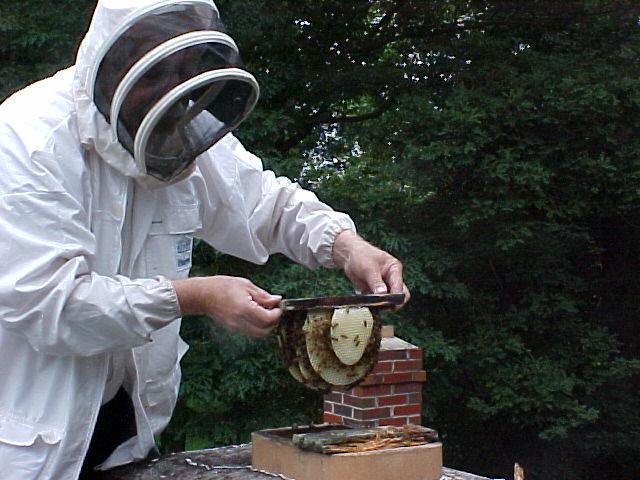
Contact a Local Beekeeper to Remove Honey Bees from Your Structure in Hampton Roads, Virginia
 If a property owner suspects that a honey bee colony has entered the wall of a structure, he/she should attempt to confirm the insects are indeed honey bees. Other possible insects that might invade the wall of structures are carpenter bees, yellow jackets or European hornets. Honey bees vary in color from yellow to black, have black or brown bands across the abdomen and are much smaller than a carpenter bee.
If a property owner suspects that a honey bee colony has entered the wall of a structure, he/she should attempt to confirm the insects are indeed honey bees. Other possible insects that might invade the wall of structures are carpenter bees, yellow jackets or European hornets. Honey bees vary in color from yellow to black, have black or brown bands across the abdomen and are much smaller than a carpenter bee.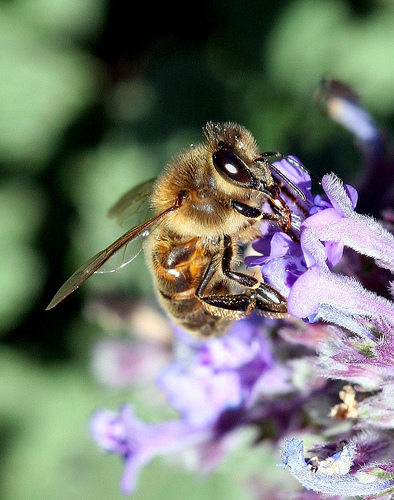 Honey bees are about 2/3 inch long and covered with hairs or setae. The foraging honey bees have pollen baskets on each hind leg, which will often be loaded with a ball of yellow or dark green pollen. The honey bee is the only stinging insect that can normally overwinter as a colony inside the wall of a structure in Virginia.
Honey bees are about 2/3 inch long and covered with hairs or setae. The foraging honey bees have pollen baskets on each hind leg, which will often be loaded with a ball of yellow or dark green pollen. The honey bee is the only stinging insect that can normally overwinter as a colony inside the wall of a structure in Virginia.
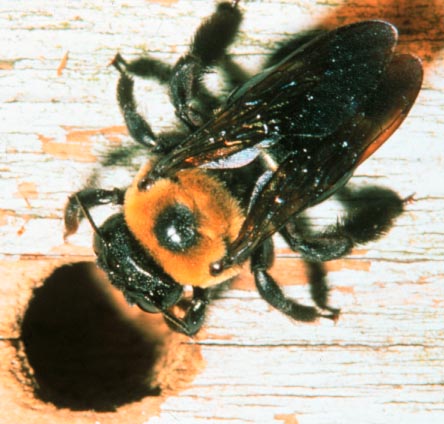
The carpenter bee can be identified by having bright yellow, orange or white hairs on the thorax (chest region) and a black shiny abdomen on the dorsal side. Carpenter bees are robust, heavy-bodied bees that range from ¾ to 1 inch in length. These insects bore ½-inch diameter holes that appear to be perfectly round on exterior wooden surfaces.
The giant resin bee is a solitary Asian bee that has been introduced into the southeastern United States. These bees are large and quite impressive. They have a cylindrical body ranging from 1/2 to almost one inch (14 - 24 mm) in length, which is longer than most other bees in North America. The head and abdomen of the giant resin bee are black. Dense yellowish-brown hairs cover its thorax. They commonly nest in vacant carpenter bee tunnels but do not cause damage.
southeastern United States. These bees are large and quite impressive. They have a cylindrical body ranging from 1/2 to almost one inch (14 - 24 mm) in length, which is longer than most other bees in North America. The head and abdomen of the giant resin bee are black. Dense yellowish-brown hairs cover its thorax. They commonly nest in vacant carpenter bee tunnels but do not cause damage.
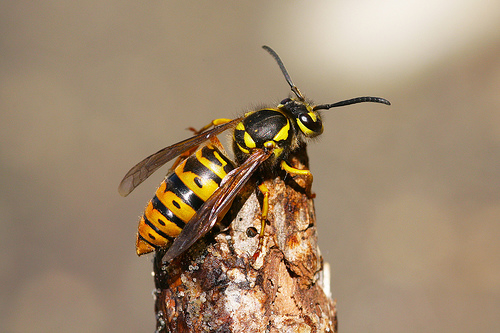
Yellow jackets lack the dense body hairs that are found on carpenter bees and honey bees. Yellow jackets do not have the pollen baskets on the hind legs. The yellow jacket is about ½ inch long, and the abdomen is characterized by having alternating yellow and black bands. Large colonies of yellow jackets are often noticed nesting underground in autumn.
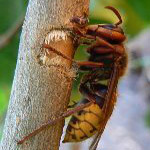
European hornets are much larger (1.5 inches long) than honey bees and sometimes establish colonies inside structural walls. European hornets have a yellow face and yellow stripes with black markings at the end of their abdomens.
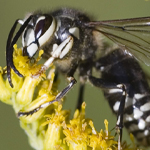
The bald-faced hornet is 1/2 to 5/8 in (1.25 to 1.6 cm) long. It is black with white markings on the face Nests can be built on the eves of buildings, on windows, in attics or on other structures.
What to do if they are not pollinators?
Per the Virginia Pesticide Control Act (2VAC5-680-20), beekeepers may not sell, use, or recommend the use of pesticides, in exchange for compensation. In order to exterminate insects on property other than their own, beekeepers must obtain a certified pesticide applicator license. Venom Collect is a Virginia based company that offers free wasp and hornet removal for Virginia residents in the Tidewater area, Eastern Shore, Richmond, and Roanoke Valley. They use a vacuum to collect the insects, freeze them to preserve the venom, and then send them to an immunotherapy company which uses the venom to produce potentially life-saving medications for those with severe allergies. For more information, you can call them at 757.710.8458
Honeybees are beneficial pollinators and should be left alone and appreciated unless their nest is in conflict with human activity. Honey bees will do no structural damage to a building. Unlike other pests, such as termites or carpenter bees, honey bees do not chew or eat wood. If honeybees nest in the walls of a home, they can be removed with the assistance of a beekeeper.
Do not attempt to plug the bees' entrance. If the entrance hole is blocked, the bees will look for another exit. They may find another crack or opening or they could follow light and enter your living quarters instead through gaps in baseboards, electrical outlets or vents. Simply injecting a pesticide in the wall to kill the bees is risky. The comb will attract wax moths and mice. The honey will attract ants and other insects and will ooze through the wall or ceiling when comb melts during hot weather. A foul odor is to be expected for several weeks in the vicinity of the decaying bees.
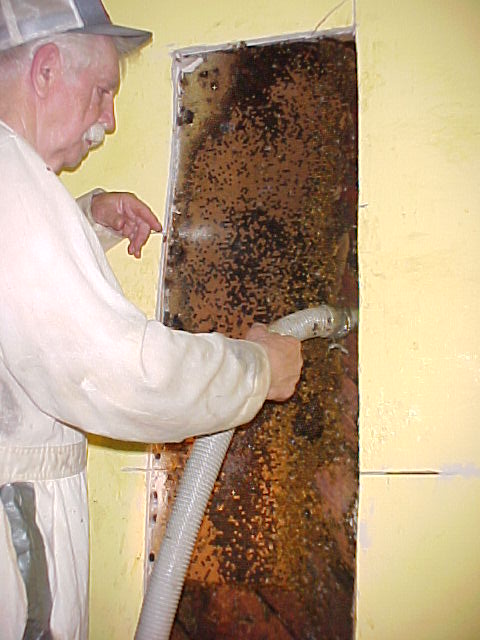
Many beekeepers have specialized equipment, such as a bee vacuum, which allows them to collect the colony intact and relocate it to an apiary. They will open the area and remove the honey and combs to prevent rodent and insect infestations which occur in abandoned nests. Also, without bees to control the temperature, the wax will melt and honey drip from the combs through plaster and drywall. After removal, the cavity should be filled with foam insulation, as the nest odor will be attractive to future swarms.
Exterior stucco, brick or cement walls make normal removal impossible, especially if interior wall accessibility is not an option. Trapping bees out of the wall with a "one-way bee escape removal" is recommended if a property owner is not in a hurry to have the colony removed. The process will take about two to three months, and sometimes it is not successful unless careful attention to detail is followed. The comb will remain in the wall and will attract another swarm in the future unless preventive measures are taken.
 A cone-shaped one-way bee escape is constructed of window screen with the large end fastened over the primary bee entrance. It is imperative that all other cracks or holes leading to the bee colony be sealed off, or the efforts will be unsuccessful. A hive body with a new queen bee inside is placed on the platform with the entrance as close to the primary entrance as possible. Returning foraging bees will fly to the base of the cone-shaped bee escape and will be unable to reenter the wall. Eventually, the foraging bees will successfully gain entrance to the new hive. Periodic checks to make sure the bees have not gained entry into the wall are necessary. As the colony in the wall weakens, the colony in the hive body will strengthen at the expense of the parent colony. The queen in the parent colony will not normally abandon her brood, so a non-residual pesticide or carbon dioxide should be injected into the wall to kill her and the remaining bees. Make sure the fumigant used does not leave a toxic residue. After four to five days, the cone escape can be removed and the bees from the new hive will enter the wall and remove the remaining honey. As soon as bee entry into the wall ceases which should only take a few days, all possible entry sites must be sealed or plugged to prevent re-colonization by future swarms. Filling the void with an expanding foam type of insulation is highly recommended.
A cone-shaped one-way bee escape is constructed of window screen with the large end fastened over the primary bee entrance. It is imperative that all other cracks or holes leading to the bee colony be sealed off, or the efforts will be unsuccessful. A hive body with a new queen bee inside is placed on the platform with the entrance as close to the primary entrance as possible. Returning foraging bees will fly to the base of the cone-shaped bee escape and will be unable to reenter the wall. Eventually, the foraging bees will successfully gain entrance to the new hive. Periodic checks to make sure the bees have not gained entry into the wall are necessary. As the colony in the wall weakens, the colony in the hive body will strengthen at the expense of the parent colony. The queen in the parent colony will not normally abandon her brood, so a non-residual pesticide or carbon dioxide should be injected into the wall to kill her and the remaining bees. Make sure the fumigant used does not leave a toxic residue. After four to five days, the cone escape can be removed and the bees from the new hive will enter the wall and remove the remaining honey. As soon as bee entry into the wall ceases which should only take a few days, all possible entry sites must be sealed or plugged to prevent re-colonization by future swarms. Filling the void with an expanding foam type of insulation is highly recommended.
Unfortunately, this trapping procedure requires many visits to the site to finish the job. The comb left behind in the wall will be highly attractive to scout bees in the future, therefore the structure owner should make annual inspections of the wall and refill any cracks or holes leading to the cavity.
You can prevent swarms from nesting in walls by preventive maintenance. Honey bees will not make an entrance to a nest. They look for an existing entrance, so periodic inspection and caulking is all that is necessary to prevent them from occupying spaces in walls.
Nests should be removed promptly from problem sites because honey bees can store a considerable amount of honey in only a few weeks. Do not procrastinate - call a local beekeeper.
